|
|
 |
|
S. Maria in Trastevere |
|
written
by ars7 / 10.06.2004 |
|
|
| |
Introduction |
| |
| |
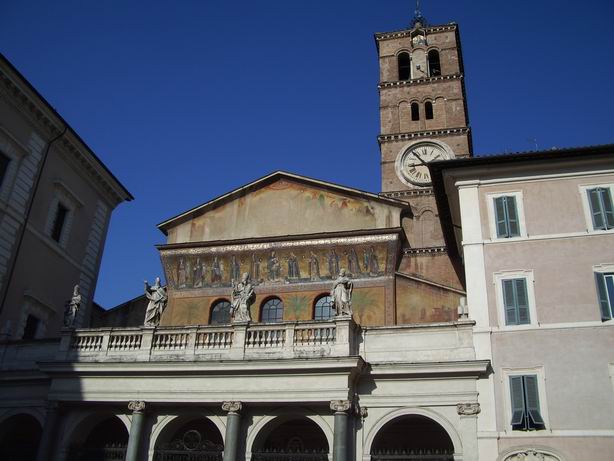
|
| Anna |
| S. Maria in Trastevere |
|
| |
|
The church of S. Maria in Trastevere is located in the heart of the Trastevere neighborhood, near Ponte Sisto. There have been religious meetings on this site for almost two thousand years; early Christians had a legend that an oil spring (fons olei) issued from the ground at this spot and flowed all the way to the Tiber, making this spot portentous. Pope St. Julius I built a church of this name here shortly after the time of Constantine, making it one of the oldest churches dedicated to Maria. The structure that exists today is not St. Julius’s basilica, though. Pope Innocent II tore down that building in 1140 and replaced it with his own, which (with a few renovations) is what one can visit today.
Pope Innocent II was born Gregorio Papereschi, a member of a rich and influential Italian family. At the papal election in early 1130, he got the minority of the vote of the College of Bishops, while his rival Anacletus II got the majority, creating a schism in the Catholic Church. Innocent fled to France, where he was confirmed as the rightful pope at the Synod of Etampes in late 1130, but Anacletus held sway over Rome. Innocent had significant support throughout Europe, especially in France and in the Holy Roman Empire—in the following years he presided over the crowning of the monarchs of both countries, and he was friends with Abbot Suger of St. Denis. In 1133 the Holy Roman Empire went so far as to invade Italy to assist Innocent in reaching the papal throne, but the operation was not able to oust Anacletus. Anacletus died in 1138 and the College of Bishops elected Victor IV to replace him. Victor was not as tenacious as Anacletus, though, and Innocent was able to persuade him to back down and let Innocent assume the papacy. The 10th Ecumenical Council, in 1139, finally laid the dispute to rest by declaring all of Anacletus’s acts to be null and reaffirming Innocent’s authority. Shortly after the Council, in 1140, Innocent started reconstruction of S. Maria in Trastevere as a demonstration of power. S. Maria in Trastevere was chosen because Anacletus had been the bishop of this church, and erasing his church was an important strategic step in erasing his memory.
|
| |
|
| |
|
| |
Description |
| |
| |

|
| Kinney |
| Floorplan |
|
| |
|
| |
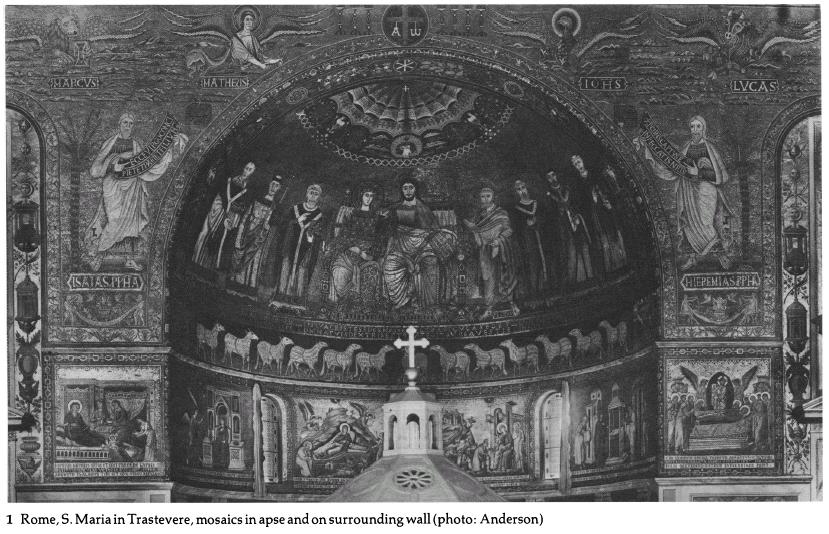
|
| Kitsinger |
| Main apse mosaics |
|
| |
|
| |
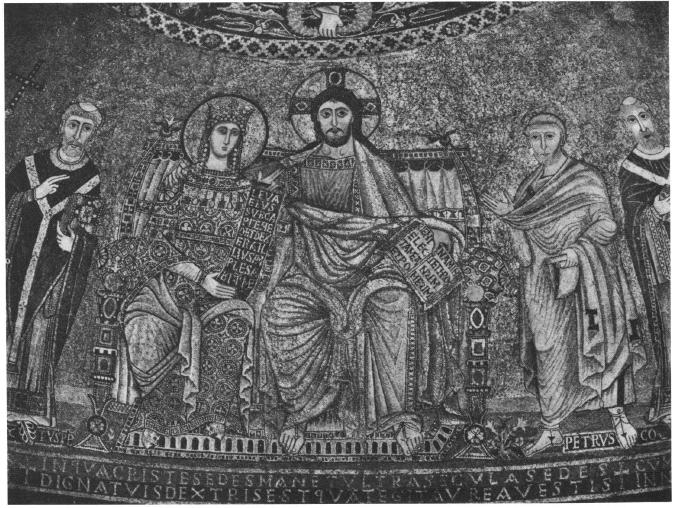
|
| Kitsinger |
| Closeup of Christ and Maria |
|
| |
|
| |

|
| Kitsinger |
| Cavallini's Maria |
|
| |
|
| |
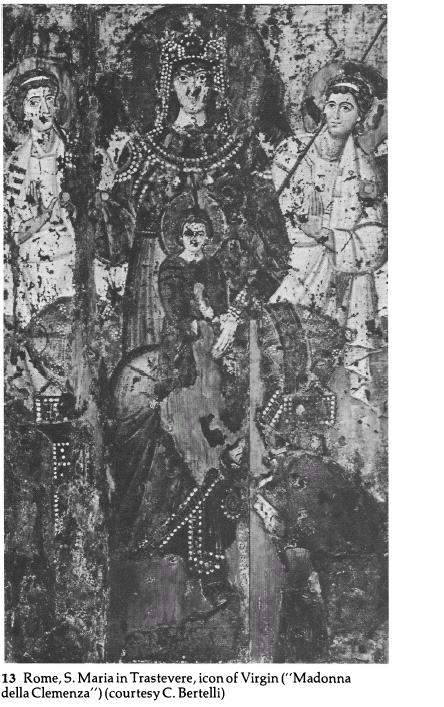
|
| Kitsinger |
| Madonna della Clemenza icon |
|
| |
|
S. Maria in Trastevere is constructed on the basilica floor plan, with a central nave, an apse, and chapels along the sides. It is done in the Romanesque style, popular in the late 1000s and early 1100s, which is characterized by rounded arches, sturdy stonework, and heavy lines. The façade was added in 1702 by Carlos Fontana and features statues of Sts. Calixtus, Cornelius, Julius and Calepodius, who are buried inside and who were important in the early history of this church. On the ceiling inside is a painting of the Assumption of the Virgin that was done by Domenichino in 1617. The beautiful Cosmatesque marble floor is from a 19th-century restoration. Madonna della Clemenza, a 7th-century icon, is displayed in a chapel near the altar.
Midway up the apse is a series of seven mosaics by Pietro Cavallini dating from 1290. They tell the story of the life of Maria: Nativity of the Virgin, Annunciation, Nativity of Christ, Adoration of the Magi, Presentation at the Temple, Death of the Virgin, and, in the center of the apse, Donor in Adoration of the Virgin. Cavallini was an important figure in the early Renaissance, and the Florentine artist Giotto di Bondone was heavily influenced by his work. These mosaics are colorful and emotional, and represent Maria as a pretty young woman with delicate, elongated features.
-------
Above the Cavallini mosaics, in the conch of the apse, is a large mosaic that was completed at the time of Innocent II. From left to right, it depicts Innocent II (holding a model of the church to identify him as the donor), St. Lawrence, St. Calixtus, Maria, Christ (centered on the axis of the nave), St. Peter, St. Cornelius, St. Julius, and St. Calepodius.
The figures of Maria and Christ are at once both very traditional and very experimental. First of all, the men’s faces are all done in the Romanesque style—they are shown straight on and have short thick lines, heavy eyebrows, and small expressionless mouths. In contrast, Maria’s face is shown with a slight side view, and she has an elongated nose and lighter, more emotional features in the Byzantine style; she looks more like Cavallini’s Maria than the contemporary of the other figures in her mosaic. Although it has been proposed that Cavallini restored her face, analysis of the mosaic’s structure shows that this could not have occurred. Rather, it appears that Maria’s features are copied from the icon of S. Maria Nova, which was 500 years old in Innocent’s time. (Remember S. Maria Nova, she’ll turn up again later.)
Despite the ancient reference made by Maria’s face, her pose is highly innovative. She is displayed as sponsa, the bride of Christ: she shares his throne, wears his crown, and embraces him. This “synthronos” pose begins to appear in several places in the early-mid 1100s, from Solomon and wife in a French bible to an illustration in the Song of Songs at Cambridge to a similar miniature in a German manuscript, but there is no strong evidence that this mosaic was influenced by any of these sources.
Christ holds an inscription saying “veni electa mea et ponam in te thronum meum,” and Maria holds one saying “leva eius sub capite meo et dextera illius amplesabitur me.” These are both paraphrases of the liturgy of the Feast of the Assumption festival, which is itself a paraphrase of the Song of Songs.
-------
The nave is lined with mismatched marble columns, 11 on each side. Eight of these (S 5/6, N 3/4, N 5/7, N/S 8) have capitals that are spolia taken from the Baths of Caracalla. They feature the faces of either a young woman whose long hair is covered by a veil, or an older man with a full beard. In the volutes are small, androgynous, playful figures holding their fingers to their lips. Many of the capitals have been damaged over time, but all these figures are clearly discernable on S 5/6.
|
| |
|
| |
|
| |
Function |
| |
| |

|
| Kitsinger |
| Christ from the main mosaic |
|
| |
|
| |
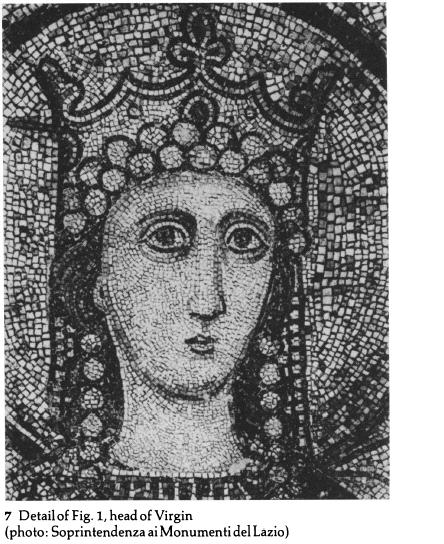
|
| Kitsinger |
| Maria from the main mosaic |
|
| |
|
| |
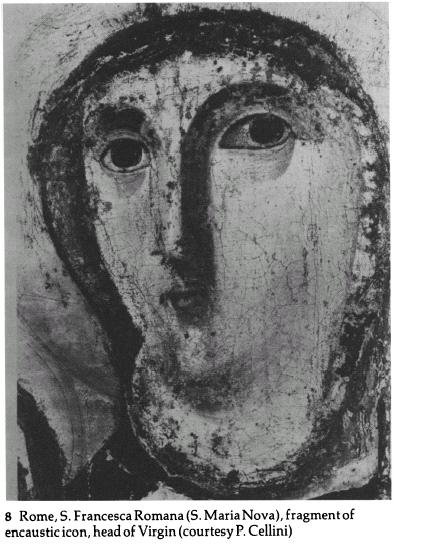
|
| Kitsinger |
| S. Maria Nova |
|
| |
|
| |
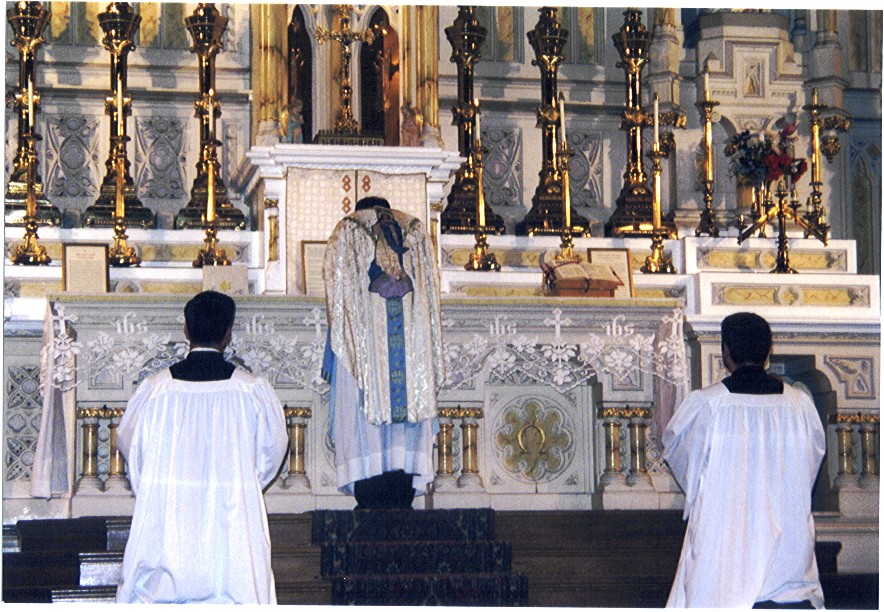
|
| holytrinitygerman.org |
| Feast of the Assumption in modern America |
|
| |
|
(I am changing the organization of the next two sections: section 3 discusses the context, contemporary perceptions, and patron's intentions of the apse mosaic; section 4 does the same for the columns.)
Mosaic
By now you should be curious about what ties the main mosaic together. What could connect early icons of Maria, creative synthronos depiction, and the Song of Songs? The answer lies in the Feast of the Assumption. This festival began in Rome by 757 CE, and continues in some Lazio towns even today. It involves a midnight procession on August 15 in honor of the death of Maria. In Innocent II’s time, a host of clerical and secular officials would walk around Rome carrying the acheropita, an image of Christ not made by human hand. Icons, revered paintings of holy figures, were very important in Catholic worship at this time, and were treated almost as humans. The procession started in S. Giovanni Laterano, went to first to S. Maria Nova (where prayers were said and the icon’s feet were washed), continued to S. Adriano (where the icon’s feet were washed again), and passed S. Lucia in Orphea to end at S. Maria Maggiore. There was an important icon of Maria at S. Maria Nova, and the icons of Christ and Maria may have bowed to each other there.
Clearly, a main theme of the Feast of the Assumption is Christ’s devotion to his mother. This is reflected in the synthronos theme and in the inscriptions. Christ’s inscription translates as “…I will place in thee my throne,” which in the liturgy refers to Christ placing his throne in the heavenly city of Jerusalem. Liberties have been taken with the translation in the design of the mosaic, though. The depiction is of the slightly modified phrase “I will place thee in my throne,” of Christ honoring his mother by taking her into his throne in the most prominent part of the mosaic. This design supports the Cult of Maria, which was very popular at this time in the Catholic Church.
Innocent II chose to include in this mosaic many allusions to well-known Roman ceremonies and widely held beliefs. This was a smart choice for a pope trying to consolidate his power, because he knew that anyone who entered the church would see the mosaic and recognize its references and agree with his overall statement. Also, there is a more subversive side to this mosaic. When Anacletus was bishop of S. Maria in Trastevere he had the icon of Madonna della Clemenza in a very visible location. By emphasizing S. Maria Nova and relegating Madonna della Clemenza to a much less prominent place in the church, Innocent removed a reminder of Anacletus from visitor’s minds.
|
| |
|
| |
|
| |
Patron |
| |
| |
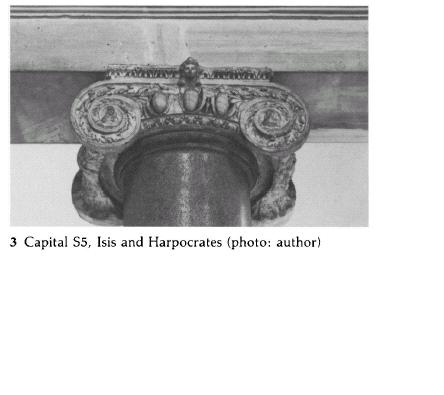
|
| Kinney |
| Female and finger-to-lips figures |
|
| |
|
| |

|
| Kinney |
| Male and finger-to-lips figures |
|
| |
|
Columns
Innocent II was by no means original when he chose to appropriate part of one monument and incorporate into his own. Spoliation had been occurring for centuries. The Theodosian Code of 438 CE put public monuments under the emperor’s protection; the emperor had the power to stop anyone else from damaging monuments, but he could also authorize the removal of spolia for special cases. In the 8th century, after the fall of the empire, a document called the Donation of Constantine was forged, which retroactively gave this same power to the pope. Most popes had a difficult time enforcing their control in that age of barbarian invasions, and in fact the Catholic Church did more looting than any invading force. Innocent realized, as many did, that using spolia was a cheap and easy way to advertise one’s position as Pope, and at this time there was not even a Roman Senate to object.
It is difficult for modern viewers to know what significance medieval churchgoers would have assigned to the three figures in the capitals. Considered in the context of the mosaic, the male/female pair could have referred to numerous religious examples of sponsa—Maria and Christ, Maria and Joseph, Solomon and wife, Adam and Eve, etc. Each of these interpretations would have reinforced the mosaic’s message of divine purity of the depicted partnership. On the other hand, the faces could have been intended to contrast with this message. Many viewers would have recognized the capitals as having come from the Baths of Caracalla, and might have thought that the male figure was the much-despised emperor Caracalla. Very little was known about him by this time because he was put under erasure, but sources say that he slept with his stepmother Julia. People familiar with these sources would then have seen the female figure as Julia, and this unholy union would contrast severely with the divine pair in the mosaic.
There are also several possible interpretations of the third figure. Generally, holding a finger to one’s lips meant the same things in the Middle Ages that it does now: silence or secrecy. It could be the silence of personal prayer or the secrecy associated with imperial power. Or, more abstractly, it could be the misleading ideas and self-deception (as the Catholics saw it) of the false worship conducted by the ancient pagan cultures. Medieval observers would have mixed and matched all these interpretations as they saw fit, but always with the conclusion that worship of Christ and Maria was right and holy.
|
| |
|
| |
|
| |
Conclusion |
| |
As stated earlier, the synthronos theme was just becoming common when Innocent II commissioned the apse mosaic, and it was continued throughout Europe in the following decades. More than one hundred years later, this mosaic was so influential on Cavallini that he directly copied the style of Maria’s face for his own mosaic series. Even today, the beautiful rich colors and clear piety of the mosaic have persisted and inspire reverence in visitors to S. Maria in Trastevere.
-------
The spolia columns are very interesting to the modern scholar, since we have access to information that people in the Middle Ages did not. In the Baths of Caracalla, the three figures did not symbolize any of the things I have proposed so far: they were in fact the Egyptian gods Isis, Serapis/Osiris, and Harpocrates/Horus. Egyptian gods were popular at the time of Caracalla, and Serapis was associated with the Library of Alexandria, so it would make sense for the ancient Romans to depict these gods on the capitals of their bath library. Isis was the goddess of fertility, her husband Serapis was the god of death, and their son Harpocrates was the god of the sun. Harpocrates was often depicted as a child with his finger to his lips, which implied childhood in Egyptian culture—nothing to do with silence.
|
| |
|
| |
|
| |
Personal Observations |
| |
I enjoyed learning about the Feast of the Assumption ceremony. It is fascinating to visualize hundreds of people parading through the streets of Rome behind a small and deteriorating painting, singing and praying and expressing their religious fervor. Such a festival was hard to imagine before coming to Rome, but now that I am here I understand how it could have happened. I can still walk down the same narrow and crowded streets, even though it would be impossible to precisely emulate their reverent fervor in the midst of motorbikes and postcard vendors.
|
| |
|
| |
|
| |
Bibliography |
| |
Kinney, Dale. “Spolia from the Baths of Caracalla in Sta. Maria in Trastevere.” The Art Bulletin, Vol. 68, No. 3. (Sep., 1986), pp. 379-397.
Kitsinger, Ernst. “A Virgin’s Face: Antiquarianism in Twelfth-Century Art.” The Art Bulletin, Vol. 62, No. 1. (Mar., 1980), pp. 6-19.
http://ah.bfn.org/a/archsty/rom/#rom
http://www.findagrave.com/cgi-bin/fg.cgi?page=gr&GRid=6926275&pt=Pope%20Innocent%20II
http://www.kfki.hu/~arthp/html/c/cavallin/mosaic/annuncia.html
http://www.newadvent.org/cathen/08012a.htm
http://roma.katolsk.no/mariatrastevere.htm
http://www.ukans.edu/history/index/europe/ancient_rome/E/Gazetteer/Places/Europe/Italy/Lazio/Roma/Rome/churches/S.Maria_in_Trastevere/home.html
|
| |
|
| |
|
|
 |
|

